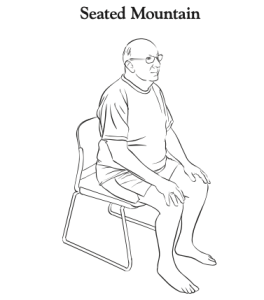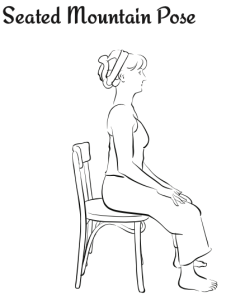By Carol Krucoff, C-IAYT, E-RYT
Relieve Pain and Enhance Health with Seated Mountain Pose
One of the most helpful yoga poses for modern life is never taught in most yoga classes. Seated Mountain Pose teaches the essential skill of sitting properly in a chair, and–as a yoga therapist–I’ve seen this posture dramatically transform how people look and feel by relieving pain and enhancing respiration, circulation, and digestion. Since most American adults spend most of their days sitting—and nearly half get no physical activity 1 —it’s not surprising that one in five suffers from chronic pain 2, and b ack pain affects an estimated 84 percent 3.
ack pain affects an estimated 84 percent 3.
Sitting all day is hard on the body, and the round-shouldered, forward-head posture that is all too common when staring at a computer can lead to a host of ailments—including headache, breathing difficulties, and bladder and bowel problems. Learning how to sit with good alignment not only helps relieve musculoskeletal pain—in the back, neck, and joints—it also supports optimal breathing, blood flow, and digestive function.
This is why Seated Mountain Pose is an essential component of our Integrative Yoga for Seniors program, developed in collaboration with Duke medical center experts, to safely and effectively adapt the yoga practice to older bodies, minds, and hearts. In most yoga classes for older adults—particularly those new to the practice—we recommend that each participant have a chair and learn Seated Mountain Pose and other important postures geared to help maintain independence, such as Chair Stand. In addition, the chair can be a helpful prop, as a support to hold onto during standing poses, and—when lying down postures are offered—the chair can be useful in making the transition from getting down to the floor and back up again.
In fact, in our Relax Into Yoga for Seniors approach, we do not teach any postures that require sitting on the floor. This is because most Americans in mid-life and beyond cannot sit comfortably on the floor and often wind up slumping, which can increase the risk of vertebral fracture in the estimated 54 percent of postmenopausal women with low bone density and an additional 30 percent with osteoporosis. 4.
For example, the commonly-taught posture of sitting cross-legged on the floor, called Sukasana, translates as “easy pose,” but it is far from easy for most older adults. Even when propped up–by sitting on cushions or folded blankets–many seniors end up with a rounded spine and pain in the knees, hips, and ankles.
We believe that yoga should be safe and functional, so we’ve taken seated poses off the floor and into the chair. In addition to relieving pain and enhancing overall health, Seated Mountain Pose can also build core strength. Postures done sitting in a chair can also stretch and strengthen other important muscles.

Sitting without the support of the back of your chair can be surprisingly demanding, so if you begin to fatigue, feel free to scoot your hips back to rest your back against the chair back. You might also put a rolled towel or small pillow in the curve at your lower back as you build the strength to sit without support.
Ideally, in Seated Mountain Pose, if someone were looking at you from the side, they’d see your ear over your shoulder and your shoulder over your hip. Seated Mountain Pose is the foundation for numerous strengthening and stretching postures, such as lifting one or both legs off the floor, extending the arms out to the sides, shrugging the shoulders, and stretching the hands, feet, and wrists. [These and other postures designed to be safe and effective for older adults are offered in our book, Relax into Yoga for Seniors: A Six-Week Program for Strength, Balance, Flexibility and Pain Relief.
In addition to stretching and strengthening the body, yoga can help relax the mind. A recent study published in the American Journal of Geriatric Psychiatry, 5 found that yoga was as effective as a traditional therapy in relieving anxiety in worried older adults. The research involved 500 seniors who either learned Cognitive Behavioral Therapy (CBT) from a licensed clinical social worker or participated in 20 biweekly, 75-minute yoga classes based on our Relax into Yoga for Seniors program. Six months after completion, CBT and yoga participants sustained improvements in worry, sleep, anxiety, depressive symptoms, and fatigue. . .with no significant between-group differences.
With New Year’s just a few weeks away, consider resolving to sit in good alignment—at your desk, behind the wheel, during meals—anytime you’re seated. Rather than sitting toward the front of your chair, as you would during a yoga practice, feel free to scoot back so you are supported by the chair back, and feel free to use a small pillow or rolled towel to help you keep the natural curves in your spine.
Resolve to make Seated Mountain pose a habit as a simple yet powerful way to enhance your health.
~~~~
Carol Krucoff, C-IAYT, E-RYT, is a yoga therapist at Duke Integrative Medicine and Co-Director of the Integrative Yoga for Seniors Professional Training
In our fast-paced world, stress is an inevitable part of life. Whether it's work deadlines, personal obligations, or unexpected challenges, we all face moments of anxiety. However, managing anxiety is crucial for our mental and physical well-being. Fortunately, several mind-body techniques can help us navigate stressful situations more efficiently and ...
READ MOREEmbarking on a journey towards better health is commendable, but connecting your health goals to a broader health vision becomes even more powerful. Your health vision serves as a guiding light, a roadmap that helps you navigate the complexities of daily choices and setbacks. In this blog post, we'll explore ...
READ MOREWhat Is a Sauna? A sauna is a small room or space that produces heat, typically using hot rocks, steam, or infrared heaters. The temperature inside a sauna can range from 150°F to over 200°F. People sit or lie in a sauna to enjoy its therapeutic effects, including sweating and relaxation. ...
READ MORE